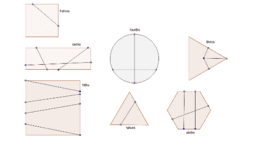Esquema
CCSS Gr. 3 Fractions and Area
Common Core Standards for Grade 3-Geometry
Reason with shapes and their attributes.
Understand that shapes in different categories (e.g., rhombuses, rectangles, and others) may share attributes (e.g., having four sides), and that the shared attributes can define a larger category (e.g., quadrilaterals). Recognize rhombuses, rectangles, and squares as examples of quadrilaterals, and draw examples of quadrilaterals that do not belong to any of these subcategories.
Partition shapes into parts with equal areas. Express the area of each part as a unit fraction of the whole. For example, partition a shape into 4 parts with equal area, and describe the area of each part as 1/4 of the area of the shape.
Common Core Standards for Grade 3-Geometric Measurement
Geometric measurement: understand concepts of area and relate area to multiplication and to addition.
Recognize area as an attribute of plane figures and understand concepts of area measurement.
---A square with side length 1 unit, called “a unit square,” is said to have “one square unit” of area, and can be used to measure area.
---A plane figure which can be covered without gaps or overlaps by n unit squares is said to have an area of n square units.Measure areas by counting unit squares (square cm, m, square in, square ft, and improvised units). Relate area to the operations of multiplication and addition.
---Find the area of a rectangle with whole-number side lengths by tiling it, and show that the area is the same as would be found by multiplying the side lengths.
---Multiply side lengths to find areas of rectangles with whole-number side lengths in the context of solving real world and mathematical problems, and represent whole-number products as rectangular areas in mathematical reasoning.
---Use tiling to show in a concrete case that the area of a rectangle with whole-number side lengths a and b + c is the sum of a × b and a × c. Use area models to represent the distributive property in mathematical reasoning.
---Recognize area as additive. Find areas of rectilinear figures by decomposing them into non-overlapping rectangles and adding the areas of the non-overlapping parts, applying this technique to solve real world problems.
Geometric measurement: recognize perimeter as an attribute of plane figures and distinguish between linear and area measures.
Solve real world and mathematical problems involving perimeters of polygons, including finding the perimeter given the side lengths, finding an unknown side length, and exhibiting rectangles with the same perimeter and different areas or with the same area and different perimeters.
